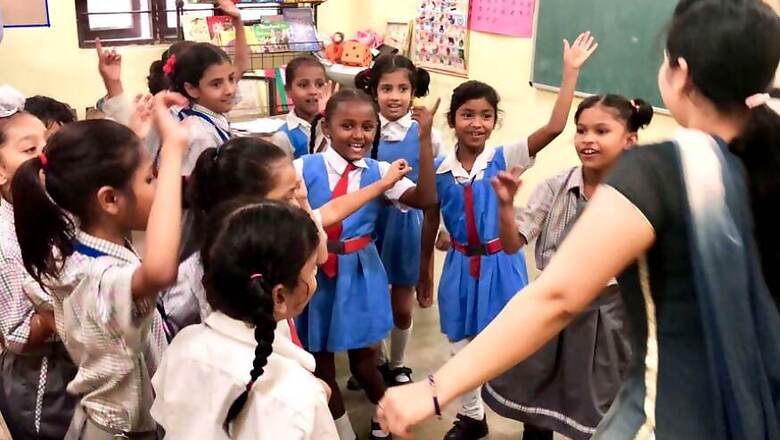
views
New Delhi: In success for Delhi government's project to curb dropout rate in schools, girls have outnumbered boys in both enrolment and results.
The Aam Aadmi Party government tied up with National Institute of Open Schooling for providing an opportunity to children to complete their school education.
In 2017, students who failed in class 9th or 10th met CM Arvind Kejriwal and Education minister Manish Sisodia requesting they should be given another chance to sit for exams. Many girls, who were part of the group, wanted an opportunity to escape being pushed into marriage and domestic work.
The scheme was aimed at those children who failed to clear class 9 examinations for two years and class 10 in the 2016-17 session. Total 8,244 students sat for the exams, and out of them 4,914 were girls, 3,330 were boys that appeared for the exam. Out of this number 2438 girls, which is 49% and 1110 boys, which is 33.33% cleared the exam. In the NIOS-Delhi government board exam conducted, 43% is the pass percentage.
The girls' participation is quite high in this alternative exam system. They have also got higher pass percentage. Speaking to News18, Atishi Marlena, former advisor to Education Minister Manish Sisodia, said, “Girls are more committed than boys because the girls know if exams are not cleared the parents might just get them married off or force them to work at home – that are the only two options available for them.”
Echoing Marlena’s views is Iqra Khan, daughter of Shah Zaman, chicken meat seller in Lakshmi Nagar. Khan is busy with her class 11th admissions, she said, “The Open Schooling exam saved me from a bleak future. In another scenario, I would have been made to learn silai, kadhai, (tailoring) or join a beautician in a parlour. But right now, I am busy with getting admissions in class 11.” She scored 67%. She recalled the time she failed for the first time, “It was difficult but my family supported me, and I got another opportunity. Now I can study,” she said.
Zainab Fareen, who scored 66.8%, and is daughter of Alauddin, a labourer, said, “I would have been made to sit at home and help family. I was weak in Science and Mathematics, now with the new arrangement I sat for Hindi, English and painting. I was quite focused this time, and stopped using the phone for amusement.”
Taxi driver Devki Nandan Gupta is happy that his daughter Swati Gupta has scored good marks and can study further. Like a daily ritual, he used to daily take her to school from Arya Nagar to RK Puram. “She is only in class 10th and I will let her decide for her life and education. I will work hard to educate her, I don’t have to worry much about her marriage now,” he said.
The students are now busy with seeking admissions in class 11th though some are unhappy with getting vocational stream – “despite working hard". But the system works on the cut-off and marks decide the courses you can take. It has nothing to do with the board.
“Now my daughter can study as much as she wants. I am not worried about her wedding. We will support her,” said Guddee, whose daughter scored 70.4 percent.
How the NIOS exam for Delhi government school came about?
In 2017, students who failed in class 9th or 10th met CM Arvind Kejriwal and Manish Sisodia requesting they should be given another chance to sit for exams. The request came after the students performed poorly in Patrachar Vidyalaya Scheme of the Central Board of Secondary Education. This was the prevalent option before the tie up with NIOS. Under the Patrachar scheme, the CBSE offers 10th CBSE correspondence. Students who failed in class 9th could also apply for the class 10th without wasting their one year. The students who have to drop their studies or who are unable to attend the school regularly also can continue their studies through correspondence facility of CBSE.
At the time of announcing NIOS-Delhi government scheme Sisodia had said that students who failed in Class X usually dropped out later and to avoid that he gave another chance through NIOS Board exam, which is simpler, offers exams in three subjects and has credits.
Marlena said, “The exam was the result of students' request, who wanted another chance.”
Some students who sat for the NIOS board were also part of Delhi government school’s another initiative to correct the faulty learning pattern, called “Vishwas group”, and this included the students who were out of school and had failed twice in the class. “But that group didn’t much benefit me,” said Khan, one of the students from the group.
There were other initiatives to improve learning like, Delhi government schools also started the “Chunauti” scheme — a project to improve learning levels in the children. The students of Delhi government schools from Classes VI to IX, were divided into groups depending on their reading and writing ability. The ones who can read are Pratibha, the non-readers are Nistha.
Reaching out to the marginalised
For this purpose of curbing the drop-out rate, the government made special arrangements to assist children who enrolled into NIOS program. The admission cum registration fees for all children was borne by the government. There were special study centers provided across the city. The curriculum and exams were by NIOS and classes were conducted with Delhi government providing the infrastructure – buildings and staff.
The former education secretary in Delhi government Punya Srivastava was very eager to make this scheme function. She has now been appointed as Joint Secretary in the Union Home Ministry.
NIOS Chairman CB Sharma said, “This is a very good idea to reach out to the marginalised section of the society – some students do not have the family support system hence they lag behind in school performance. They need extra support and with this initiative Delhi government gave them space.” He added that it was envisaged as an “initiative to reach out to the needy,” he said.

















Comments
0 comment